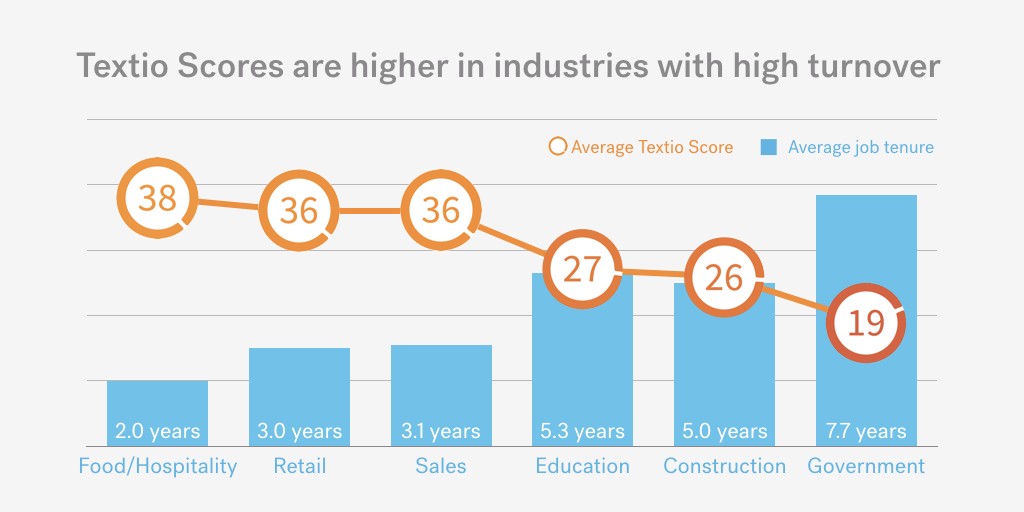Why high turnover jobs have the highest Textio scores

You’ve heard it before, the minimum timeframe you should stay in any job is 18 months. Yet, as an employer, you value longer tenure. Longer tenured employees not only keep costs down but they have a strong knowledge base and create stability in the workforce.
Unfortunately it seems like some jobs are doomed to be stuck in constant turnover. The average tenure for a job in food hospitality is two years, retail is three years, and sales is just over three years. And there are other jobs where people actually seem stuck in them forever. Average tenure of a government employee is more than seven and a half years, education over five years and construction is about five years.
Recently we took a look at all the 35 different job types in Textio to see which job types had the highest scores on average. The Textio Score is a number assigned to every document you author in Textio. It predicts how fast your job is going to fill relative to other similar jobs in your industry and market. Looking across 300 million job posts we found an interesting pattern, those jobs with the highest turnover also had the highest scores, and those with the lowest turnover had the lowest scores.
We wondered what was causing this puzzling effect. One cause may be that since retail, food hospitality, and sales are high turnover jobs, companies that employ these people need to work harder to reach the right candidates. That means they are willing to invest a bit more in great job descriptions that are free of jargon, filled with positive phrases, are engaging to read.
Another correlation might be even more surprising: the fact that these are high turnover jobs is the reason they are better scoring. Why, you might ask? One thing we know is that language is changing all the time. The words used to attract candidates this month are going to be different than last month. Therefore, if you are updating your job description every few months as opposed to every seven years, you’re going to be far more likely to use the language that is working in today’s job market.
This is a great lesson for any person or company looking to fill a position. Don’t rely on that dusty old job post you wrote a couple years ago and is sitting in some folder on your laptop. Instead, make sure you are aware of the language that is working in your industry right now to fill roles.
Just for fun we put together the full list of job types in order of best scoring to worst scoring. Find out where your position ranks:
- Food/hospitality: 38
- Retail: 36
- Sales: 36
- Consumer goods: 36
- Product management: 35
- Personal services: 34
- Marketing: 33
- Protective services: 33
- Customer service: 32
- Maintenance: 32
- Finance: 32
- Communications/PR: 32
- Design: 32
- Sports and recreation: 32
- Engineering: 31
- Transportation/shipping: 31
- Executive: 31
- IT: 31
- Manufacturing: 30
- Accounting: 30
- Project management: 30
- Arts: 29
- Agriculture: 29
- Human resources: 28
- Legal: 28
- Administrative: 28
- Research: 28
- Entertainment and leisure: 28
- Real Estate: 28
- Healthcare: 27
- Arts and/or Editorial: 27
- Education: 27
- Construction: 26
- Government: 19